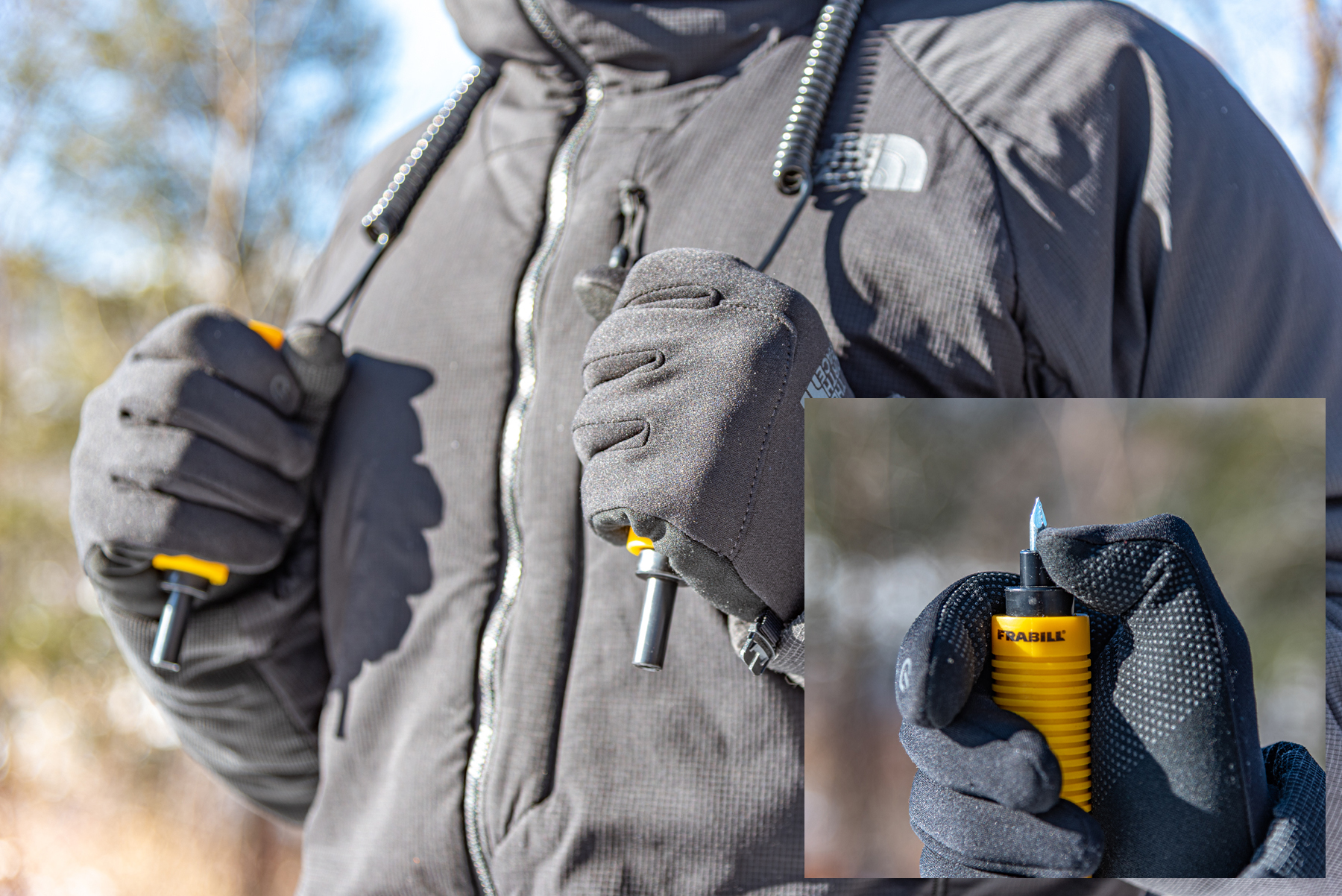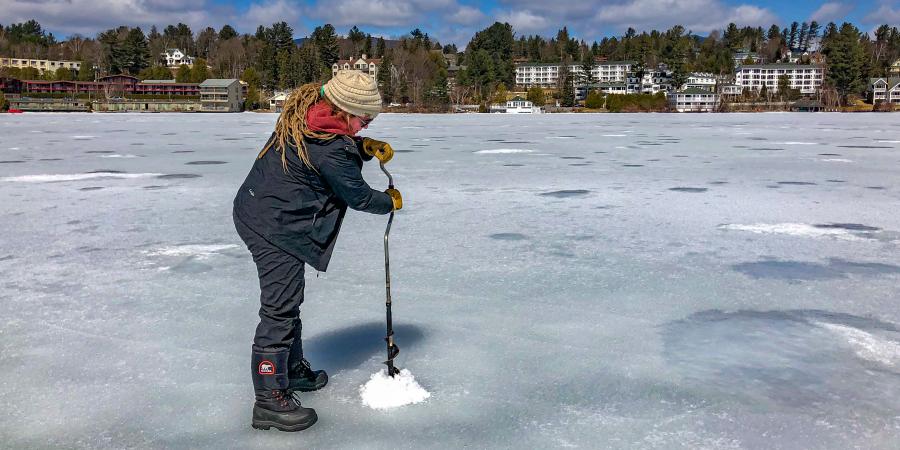As the seasons change, the activities taking place on our Adirondack lakes shifts. With the proper preparation and knowledge, recreating on a frozen lake can be a safe and enjoyable experience. When is it safe to walk on a frozen lake? How do I check the thickness of the ice? What do I do if I fall through the ice on a frozen lake? We'll answer these questions and more.
When is it safe to walk on a frozen lake?
As a general rule of thumb, ice is safe to walk on when there is 4 inches or more of clear ice. It is important to understand that different types of ice varying in their strength. Clear blue or black ice is the strongest. This ice is formed from the lake water freezing. White opaque ice is weaker and is often formed from snow falling on the ice surface, partially melting, and then freezing. Gray ice is even weaker and is formed as it starts to break down. White and gray mottled ice is the weakest and will typically be found on a lake late in the season, not long before the ice completely melts. Our recommendation is to base your decision on safety on the amount of clear blue or black ice. As an example, if you were to check the ice and find 6 inches of ice, 3 inches of clear ice under 3 inches of white ice, this would not be considered safe. Follow the old saying, "thick and blue, tried and true, white and crispy, way too risky."
Ice Thickness Recommendations Provided By NYS DEC
2 inches or less: Stay Off
4 inches: Ice fishing or other activities on foot
5 inches: Snowmobile or ATV
8-12 inches: Car or small pickup
12-15 inches: Medium truck
The recommendations and information above are for non-running waters. We advise people to stay off the ice over moving or running water, such as the Ausable River. Ice thickness over running water can be highly variable and falling through can result in being pulled under the ice. It is also important to stay away from inlets and outlets, as well as bubblers around docks and marinas.
Support our water quality work for clean water and healthy streams. Give with confidence today!

How do I check the thickness of the ice?
There are many ways to check how thick the ice is. Each has its own advantages and disadvantages. Never assume the ice is thick enough to be safe, even if you see other people out on the lake or pond. It is also important to check the ice in several locations, as the thickness may not be uniform across a body of water.
Ice Auger: A hand, gas, or electric ice auger is one of the most commonly used tools to check the ice. The smaller the diameter of the auger the easier it is to operate and cut a hole in the ice. A small 4-inch diameter hand auger is a great tool to quickly check the ice. Augers are commonly used by those ice fishing, but may not be practical for people skating, snowshoeing, or skiing.
Cordless Drill: A cordless drill with an 18" wood-auger bit is a faster and lighter weight option than an ice auger. Tape markings on the bit at 4, 5, 8, 12, and 15 inches will allow you to quickly gauge the thickness of the ice. A small tape measure put down the hole will give a more accurate measurement.
Ice Screw: These are designed for use in ice climbing but can also be used to check the thickness of lake ice. The ones with a built-in crank can be screwed into the ice fairly easily and quickly. They come in a variety of lengths, the longest is 21cm (8 inches) which is the best for judging the safety of ice. Couple this with a thin measuring tape and the thickness of ice can be measured very quickly as long as it is less than 8 inches. This makes this an ideal tool for those recreating on foot, such as skating, snowshoeing, and skiing.
Ice Chisel or Spud: These large, and heavy, metal bars with a chisel on one end can be used to quickly chop through the ice. The advantage of these over ice augers is they allow for holes of custom size to be cut in the ice. The disadvantage is they are heavy and not practical to carry if traveling long distances.
Test Pole: These long wooden poles with a large nail inserted into one end and then ground to a point are commonly used by Nordic skaters. They do not necessarily allow for a precise measurement of ice thickness, but an experienced skater can use them to quickly assess the safety of the ice. These should only be used by those with extensive experience with ice safety and self-rescue.
What do I do if I fall through the ice on a frozen lake?
No ice is completely safe ice. Even if you are checking the thickness of the ice and think it is safe, it is still possible that you will come across an area of weak ice and fall through. It is important to be prepared to self-rescue so you can survive and fall through the ice.

A pair of hand-held ice picks can be a lifesaver if you fall through the ice.
The first thing to do if you find yourself falling through the ice is to stay calm, control your breathing, get your arms over the top of the ice back in the direction you came from. One of the most important pieces of ice safety gear you can carry is a set of hand-held ice picks. These are best kept draped around your neck. They will help you pull yourself back onto the ice. When getting back onto the ice don't try to lift yourself up, instead, kick or pull yourself horizontally onto the ice surface. This method is easier and reduces the risk of further breaking the ice. Once on the ice, rolling across the surface back in the direction you came. Rolling as compared to walking or kneeling will spread out your weight and decrease the chance you will break back through the ice. Wearing a life jacket, especially when the ice is thin, is a good idea, especially for children or those not comfortable in the water.
Once out of the water and back on the ice, your biggest concern is hypothermia. When venturing onto the ice it is important to carry a change of clothes in a dry bag inside your backpack. Training in wilderness first aid will provide further information on how to prevent and treat hypothermia.
Finally, always travel with a buddy. When traveling with your buddy or buddies, be sure to travel single-file and space out. Give yourself more space on ice that is thinner or that you are uncertain of. This will limit the chance that you and your buddy go through the ice at the same time. If your buddy goes through the ice stay back, call for help, keep them calm, and if they can get themselves out be prepared to treat them for hypothermia. It is also good to carry a length of rope or webbing that can be thrown to them to help them out of the water.
View the video at the top of the page to learn more about how to survive a fall through the ice.
Sign-up for our e-newsletter to get weekly updates on the latest stories from the Ausable River Association.

